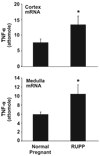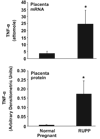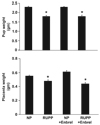Hypertension in response to chronic reductions in uterine perfusion in pregnant rats: effect of tumor necrosis factor-alpha blockade
- PMID: 18981324
- PMCID: PMC2788766
- DOI: 10.1161/HYPERTENSIONAHA.108.120881
Hypertension in response to chronic reductions in uterine perfusion in pregnant rats: effect of tumor necrosis factor-alpha blockade
Abstract
Reductions in uterine perfusion pressure (RUPP) in pregnant rats is associated with increased tumor necrosis factor-alpha (TNF-alpha). This study was designed to determine the role of endogenous TNF-alpha in mediating changes in arterial pressure and endothelin-1 (ET-1) in RUPP rats. To achieve this goal we examined the effect of RUPP in the presence and absence of a TNF-alpha-soluble receptor, etanerecept (0.4 mg/kg). Mean arterial pressure increased from 102+/-1 mm Hg in normal pregnant (NP) rats to 134+/-3 mm Hg (P<0.05) in RUPP rats. Serum TNF-alpha increased to 40+/-7.6 pg/mL in RUPP rats (n=24) versus 14.8+/-3.3 pg/mL (n=16; P<0.05) in NP rats. Administration of etanerecept decreased TNF-alpha in RUPP rats (n=20) to 17.2+/-3 pg/mL and mean arterial pressure to 118+/-2 mm Hg (P<0.05). Tissue ET-1 decreased in etanerecept-treated RUPP rats compared with control RUPP rats. The direct effect of TNF-alpha blockade on endothelial activation in response to placental ischemia was examined in human umbilical vein endothelial cells. ET-1 secreted from human umbilical vein endothelial cells treated with RUPP serum was 59.2+16 pg/mg and decreased when etanerecept was added to the medium with RUPP serum (7.60+/-0.77 pg/mg), as well as in response to serum from etanerecept-treated RUPP rats (7.30+/-0.55 pg/mg; P<0.001). ET-1 secreted from human umbilical vein endothelial cells was 15.6+/-2 pg/mg when treated with NP serum. These data support the hypothesis that endogenous TNF-alpha is an important stimulus for ET-1 in response to placental ischemia and is important in mediating endothelial cell activation and hypertension during pregnancy.
Figures






References
-
- Minagawa M, Narita J, Tada T, Maruyama S, Shimizu T, Bannai M, Oya H, Hatakeyama K, Abo T. Mechanisms underlying immunologic states during pregnancy: possible association of the sympathetic nervous system. Cell Immunol. 1999;196:1–13. - PubMed
-
- Fisher SJ, Martin JM. Defects in placentation and placental perfusion. In: Lindheimer M, Roberts JM, Cunningham FG, editors. Chesley’s Hypertensive Disorders in Pregnancy. II Ed. Stamford, CT: Appleton and Lange; 1998. pp. 377–394.
-
- Ashworth JR, Baker PN, Warrend AY. Plasma from preeclamptic women induces a functional change in myometrial resisitance arteries. J Soc Gynecol Invest. 1997;4:71.
-
- August P, Lindheimer MD. Pathophysiology of preeclampsia. Hypertension. 1995;142:2407–2426.
-
- Roberts JM, Lain KY. Recent Insights into the pathogenesis of preeclampsia. Placenta. 2002;23:359–372. - PubMed
Publication types
MeSH terms
Substances
Grants and funding
LinkOut - more resources
Full Text Sources
Medical
Miscellaneous

